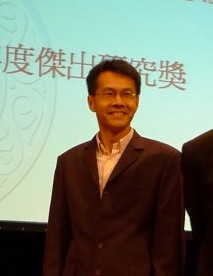
Fig. 1 The Tevatron,
Fermi National Accelerator Laboratory, near Batavia,
Illinois , USA. The photo shows the Main Ring and Main Injector
as seen from the air.
(From
http://www.fnal.gov/pub/inquiring/physics/accelerators/index.html)

Fig.
2
The dijet invariant mass distribution found in the new Tevatron
experiment.
The sum of electron and muon events is plotted. In
the left plot, CDF show the fits
for known processes with the
addition of a hypothetical Gaussian component (c).
On the right
plot CDF show, by subtraction, only the resonant contribution to
 including including
 and and
 production
and the hypothesized narrow Gaussian contribution (d). production
and the hypothesized narrow Gaussian contribution (d).
(from
CDF [1], reprinted with permission of APS and the authors)

Fig. 3: Production cross sections for
 versus versus
 at
the Tevatron at
the Tevatron
( TeV).
(from
Cheung and Song [2], reprinted with permission of APS and TeV).
(from
Cheung and Song [2], reprinted with permission of APS and
the authors) |
¡@ |
The year 2011 is perhaps the last year of running for
the Tevatron, which is subject to a severe budget cut.
It has been giving insights and challenges to the high
energy community.
Nevertheless, the Tevatron would not end with fading colors,
but full of surprises. The latest surprise was
announced in April 2011. An excess was observed by the CDF
collaboration in the invariant-mass window of 120 -160 GeV in
the dijet system of the associated production of a W boson with
2 jets [1].
This
suggests new physics beyond the standard model of particle
physics. If this is a real discovery, it will be among the
greatest discoveries of recent decades. Kingman Cheung of
National Tsing Hua University, Hsinchu, Taiwan and
Jeonghyeon Song of
Konkuk University, Seoul [2] recently provided a
concise, critical, and very interesting explanation to the
excess. They suggested that a new force of nature, mediated by a
baryonic Z' proposed 15 years ago, can explain this excess.
This baryonic Z' boson is very different from the usual Z boson
as it only couples to quarks that carry baryon numbers.
Amazingly, with this special property, the baryonic Z' boson can
overcome all other constraints imposed on Z' bosons and exactly
explain the excess. Cheung and Song [2], which appeared in the
May 2011 issue of the Physical Review Letters, rapidly caught
eyes of particle physicists world-wide. The paper was cited more
than 30 times in the first month after its appearance. Further
tests for the Z' boson include looking for excess in similar
channels such as photon + 2 jets and Z+2 jets. The expected
cross sections are shown in Fig. 3. The other cross sections are
only a factor of 2-3 smaller than that of
 ,
so that they could also be observable when more data are
accumulated. The prospect at the
Tevatron looks promising. This baryonic Z' can come from some
specific versions of the grand unified theory (GUT) or some
entirely new type of models. If this observation is real and a
baryonic Z' is confirmed with more data, it will possibly lead
to the final theory of particle physics. ,
so that they could also be observable when more data are
accumulated. The prospect at the
Tevatron looks promising. This baryonic Z' can come from some
specific versions of the grand unified theory (GUT) or some
entirely new type of models. If this observation is real and a
baryonic Z' is confirmed with more data, it will possibly lead
to the final theory of particle physics.
If the associated production of a baryonic Z' boson with the W
boson accounted for the excess in
 production
observed by the CDF at the Tevatron, Cheung and Song went ahead
and analyzed other possible channels of this Z' at the Tevatron
and at the LHC, including
gZ'
and Z Z' with the production
observed by the CDF at the Tevatron, Cheung and Song went ahead
and analyzed other possible channels of this Z' at the Tevatron
and at the LHC, including
gZ'
and Z Z' with the  .
They showed that the chances of confirming this baryonic Z' is
better at the Tevatron than at the LHC because of the faster
growing backgrounds at the LHC. Unfortunately, the current
systematic uncertainties of the order of 10% cannot yield any
significant excess in both
gZ'
and ZZ' channels at the Tevatron and also at the LHC.
Nevertheless the search using the .
They showed that the chances of confirming this baryonic Z' is
better at the Tevatron than at the LHC because of the faster
growing backgrounds at the LHC. Unfortunately, the current
systematic uncertainties of the order of 10% cannot yield any
significant excess in both
gZ'
and ZZ' channels at the Tevatron and also at the LHC.
Nevertheless the search using the
 decay
mode of Z' is much more feasible at the LHC, provided that the
branching ratio decay
mode of Z' is much more feasible at the LHC, provided that the
branching ratio  .
In particular, the .
In particular, the  mode
has a signal-to-background ratio larger than 1. Even with 1 fb mode
has a signal-to-background ratio larger than 1. Even with 1 fb luminosity
at the LHC it can lead to a high significance level. The luminosity
at the LHC it can lead to a high significance level. The
 and and
 are
also highly observable at the Tevatron. More details can be
found in the follow-up paper by Cheung and Song [3], which will
appear in Physical Review D. are
also highly observable at the Tevatron. More details can be
found in the follow-up paper by Cheung and Song [3], which will
appear in Physical Review D. |



